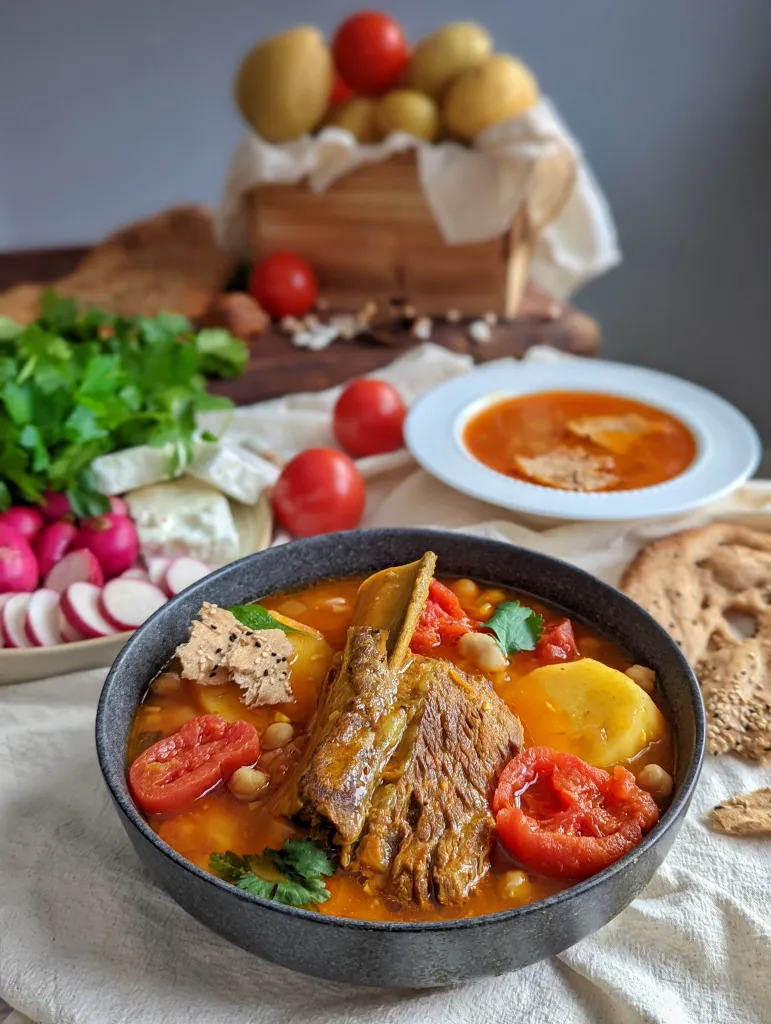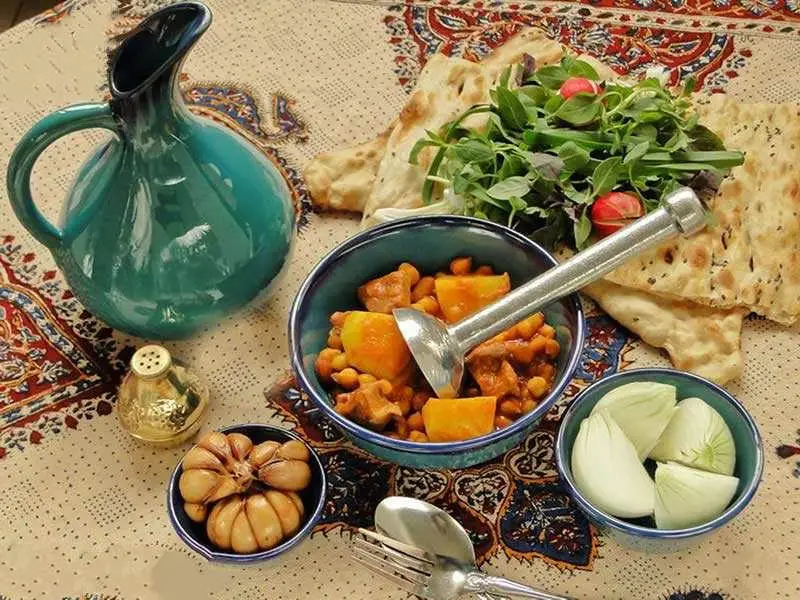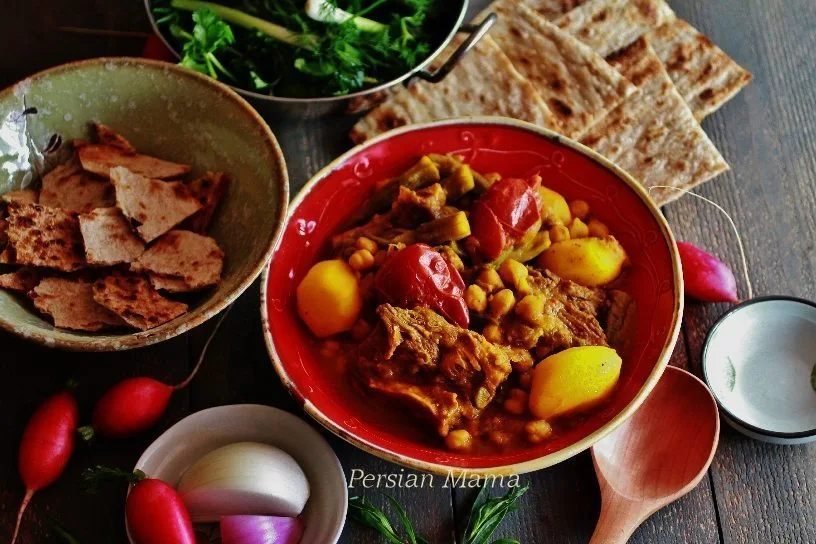Persian Cuisine Abgoosht: The Hearty Persian Stew

Today we have the Persian Cuisine Abgoosht, a traditional stew that will take you back to your grandma home… Yum.. yum…and this is more than just food; it’s serves with love & cultural history. Lebanese Lamb and Bean Soup. This dish is called Hummus. It is a mix of lamb, chickpeas, white beans, and tomatoes. They cook it slowly with a layer of onion. The dish is delicious, like turnip greens and beef stew. But what does it really mean?— It’s vegetables! —Improvisation Trying simple flavors in un-sweetened or raw forms using garlic powder on meats (overripe). Abgoosht is a Persian dish, with a long history.
It’s a humble but vital recipe for many households. Abgoosht is a food that warms your body and soul. It nourishes like nothing else. It adds power to family gatherings and casual meals.Abgoosht is a term that defines comfort food in Persian households. It is traditionally called at the table–a time when family and friends come together to not only eat but also mingle,banter. The process of making Abgoosht is a ritual, one that involves time & patience and care. Each ingredient slowly matures and comes together, resulting in a medley of Persian flavors. At first, this slow-cooked stew looks stripped-back. But, it embodies centuries of Persian culinary tradition. So, it’s a must-try for those exploring Iran’s rich culture.
History of Abgoosht

Persian Cuisine Abgoosht (Aubgusht): Traditional Dish in Ancient Persia The Persian abguhst which is served tasty and delicious…medium.com. The simplicity of the ingredients, and one-pot cooking method are what made lasagna such a popular meal for anyone with little time or money. But, over the years, Abgoosht has risen from a crowd dish to a favorite. The food changed as it moved from place to put inside Iran, with each possible region adding its very own extraordinary contort on the formula. While ingredients may vary slightly by region, the essence of lamb and legumes in a flavorful broth has not. Abgoosht is a forever classic GENGTOTO.
In the old Persian way Abgousht were made in ancient clay pots and these pots will be slowly cooked all night or day with good wood fire to finally served. The flavor pools into an otherworldy meat-seawater broth, giving the dish slow-cooked depth and character. Today, though the humble clay pot and open fire are likely substituted with stovetops and pressure cookers, Abgoosht is essentially what it was centuries ago. However, it is still not a dish that should be taken lightly as it takes time and patience with an appreciation for the art of slow cooking.
Abgoosht has a great cultural significance.
For those familiar with Persian culture, food is not just a means of nourishment but also an opportunity to bring people together over similar customs. Such is the case with Abgoosht. It is typically served at family events, following day-long preparation and shared amidst hungry mouths around the table. From the process of choosing just the right ingredients to simmering it for hours, making Abgoosht is akin to being Persian–patient, mindful and hospitable. Abgoosgt is, for many Iranians more than a meal — it’s emblematic of their culture and something that connects them to where they came from.
Abgoosht plays a very important role in the family, along with religious and cultural celebrations. This is the time of Abgoosht in such large quantities, it becomes a dish independent to serve many and not one you’d reserve just for your immediate family. They are overall a great dish because they keep things pretty simple, but pack rich flavors and feel satisfying enough that you can use them as sort of major side character for so many occasions. Abgoosht, to this day, plays an integral part in keeping Persian food traditions alive and bringing people together with every spoonful shared.
Basic Ingredients in Persian Cuisine Abgoosht Traditional
Abgoosht simply consists of a handful of essential ingredients: lamb, chickpeas, white beans and potatoes combined with tomatoes and Persian spices. The three ingredients work together to provide the essence and feel of this dish. The lamb brings an intense richness and depth, while the legumes provide heartiness and a super creamy mouthfeel. It is thickened with potatoes and tomatoes for substance and flavor, while the spices add depth of complexity. These ingredients, when combined and left to simmer for a while make the best deliciousness.
In Abgoosht, lamb (and the quality/purity of your water) is what makes or breaks this dish- so selecting your meat carefully pays off. Meat should be soft and tasty, lots of fat to make broth rich. The dish is centered around chickpeas and white beans, which lend it a hearty texture as well ample protein. The potatoes lend it some body and as well the tomatoes providing a little of sweetness / tang. Everything culminates in the spices—usually a mix of turmeric, cinnamon and dried lime—in which case all flavors collide for each cheerful mouthful.
How to Make Persian Cuisine Abgoosht

It might be daunting at first. But, making Persian Abgoosht from scratch is worth it. It sounds scary, but with the right ingredients and patience, it pays off. You start with the packing,so lamb chickpeased white beans potatoes tomatoes & herbs. However, begin by soaking the chickpeas and white beans overnight (to make sure they cook at all). Next, sear the lamb in a large pot on all sides to create those deep caramel notes. In with the soaked legumes, potatoes and tomatoes, along with water to cover everything. Simmer over low heat. Turn down the flame and let it simmer for hours until the meat is soft and tender, yet full of flavor.
When abgoosht is ready, the traditional method to serve this dish is by separating broth and solids. The red broth is eaten as a soup, ideally with chunks of bread e.g. as an accompaniment to dinner but not this excessive.LogInformation icon systemFontOfSize the next owner has something along those lines he can eatupdatedAt: 20 hours ago The lamb, chickpeas, beans and potatoes are then mashed together to make a second course which might also be accompanied with more bread or pickled vegetables. The uniqueness and attractability of this two-part serving style is one important feature about Abgoosht.
Conclusion
In this way, Persian Cuisine Abgoosht means more than just a stew; it is an embodiment of Persian culinary traditions and the values that make Parkinsons culture so meaningful and permanent. Abgoosht has the ability to bring people together regardless of whether it is a family gathering or during religious celebration, and counts as one rustic Iranian meal that both nourishes your body and satisfies your soul. The languid flavors, communal eating style and historic importance of the dish is a perfect ensemble for someone who wants to dig into the core situation from which Persian food grows on.
